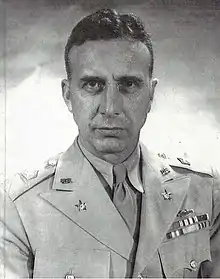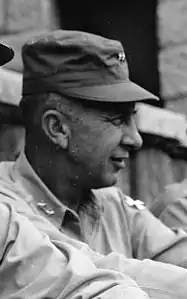Henry I. Hodes
Henry Irving Hodes (March 19, 1899 – February 14, 1962) was a United States Army four-star general who served as Commander in Chief, United States Army Europe/Commander, Central Army Group from 1956 to 1959.
Henry I. Hodes | |
|---|---|
 Henry I. Hodes pictured as brigadier general | |
| Born | March 19, 1899 Washington, D.C.[1] |
| Died | February 14, 1962 (aged 62) San Antonio, Texas[2] |
| Allegiance | United States |
| Service/ | United States Army |
| Years of service | 1920–1959 |
| Rank | General |
| Commands held | United States Army Europe Seventh United States Army Command and General Staff College 24th Infantry Division 112th Infantry Regiment |
| Battles/wars | World War II Korean War |
| Awards | Army Distinguished Service Medal (3) Silver Star (2) Legion of Merit (2) Bronze Star Medal (2) Air Medal Purple Heart (2) |
Military career

Hodes graduated from the United States Military Academy in 1920. In addition to commanding United States Army Europe, he also commanded the 112th Infantry Regiment during World War II, the 24th Infantry Division in 1952 in the Korea War, served as Commandant of the Command and General Staff College from 1952 to 1954, and was Commanding General, Seventh United States Army from 1954 to 1956.
Other assignments included Assistant Deputy Chief of Staff, United States Army from 1945 to 1949, Assistant Commanding General, 1st Cavalry Division in 1949, Assistant Commanding General, 7th Infantry Division in 1950, Deputy Commanding General, Eighth United States Army in Korea in 1951. Hodes retired from the Army in 1959. He died in 1962 and was buried in Fort Sam Houston National Cemetery in San Antonio, Texas.
Biography
Hodes began his military career in the horse mounted cavalry, in the Wyoming and Texas wilderness. He led the United States Army into the mechanized age of trucks, cars, jeeps, tanks, and airplanes. He attempted flying, but gave it up after a couple of crashes. His military career accelerated in World War II, which found him in the middle of war planning in Washington DC.
He was wounded twice in World War II, while serving with the 112th Infantry Regiment in France and Belgium. He returned to the war after receiving a shoulder wound, but was sent back to the US after receiving a head wound on September 20, 1944, which required hospitalization. Hodes became a brigadier general on January 25, 1945.
He served in the Korean War, where he was given the nickname "Hammering Hank". He served first as a field commander and later as a representative at Panmunjom – the Armistice Agreement with North Korea. His assignments during the war included Assistant Commanding General 7th Division from 1950 to 1951; Deputy Commanding General Eighth United States Army, 1951–52; and Commanding General 24th Division in 1952.
After serving in Korea, he returned to Germany. His service in post-war Europe was vital in the rebuilding efforts and designing defensive strategies opposite the communist Russians in East Germany and the Czech Republic, during the early 1950s.
He was promoted to the rank of general on June 1, 1956 and served as Commander in Chief, U.S. Army Europe and Commander, Central Army Group for NATO until his retirement from the Army on March 31, 1959.
He retired after serving more than 40 years in the US Army. He suffered from amyotrophic lateral sclerosis (ALS) and died at the age of 62 in 1962.
He had two daughters and one son, Col John Taylor Hodes, US Army (Ret). John served in Korea and 3 consecutive tours of duty in Vietnam.
Military awards
 | |||
| Combat Infantryman Badge | ||||
| 1st Row | Army Distinguished Service Medal with two Oak Leaf Clusters | |||
|---|---|---|---|---|
| 2nd Row | Silver Star with Oak Leaf Cluster | Legion of Merit with Oak Leaf Cluster | Bronze Star Medal with Oak Leaf Cluster | Air Medal |
| 3rd Row | Purple Heart with Oak Leaf Cluster | World War I Victory Medal | American Defense Service Medal | American Campaign Medal |
| 4th Row | European-African-Middle Eastern Campaign Medal with two campaign stars | World War Two Victory Medal | National Defense Service Medal | Korean Service Medal with eight campaign stars |
| 5th Row | United Nations Service Medal | Distinguished Service Order (United Kingdom) | Order of Military Merit (Korea) (Class Unknown) | Korean War Service Medal |
References
- Department of Defense appropriations for ... – United States. Congress. House. Committee on Appropriations. Retrieved 2012-02-11 – via Google Books.
- "Gen. Henry I. Nodes Dies at 62 – Negotiated With Reds in Korea – World War II Combat Leader, Once a Top Horseman, Also Headed Army in Europe". Select.nytimes.com. 1962-02-15. Retrieved 2012-02-11.
- Generals.dk entry
- "Henry I. Hodes". Find a Grave. Retrieved 2008-07-02.
| Military offices | ||
|---|---|---|
| Preceded by Anthony McAuliffe |
Commanding General of United States Army Europe 1956–1959 |
Succeeded by Clyde D. Eddleman |
| Preceded by Anthony McAuliffe |
Commanding General of the Seventh United States Army 1955–1956 |
Succeeded by Clyde D. Eddleman |
| Preceded by Horace L. McBride |
Commandant of the Command and General Staff College 1952–1954 |
Succeeded by Charles E. Beauchamp |